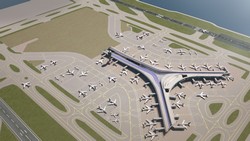 Airlines lauded the approval by the Hong Kong administration of the proposed expansion of the Hong Kong International Airport (HKIA) into a three-runway system (3RS), even as they push for self-funding so as to retain the competitiveness of the hub.
Airlines lauded the approval by the Hong Kong administration of the proposed expansion of the Hong Kong International Airport (HKIA) into a three-runway system (3RS), even as they push for self-funding so as to retain the competitiveness of the hub.
This as HKIA developer and operator Airport Authority Hong Kong (AA) in a formal statement on March 17 said they are looking at three channels of funding, one of which involves the participation of end-users in the funding scheme.
The Board of Airline Representatives in Hong Kong (BAR HK), which represents 76 airlines with operations in Hong Kong, welcomed in a statement released the same day the decision by the Executive Council of the Hong Kong SAR Government approving the construction.
Joe Ng, vice chairman of BAR HK, said the project will strengthen Hong Kong’s status as one of Asia’s premier aviation hubs.
“Our members fully support the building of a third runway, which is in the economic interest of Hong Kong. Aviation is an industry that contributes some 8% to Hong Kong’s GDP and accounts for 8% of employment in the city; the third runway is urgently needed to maintain the airport’s competitive strength and to ensure continued growth for the benefit of Hong Kong,” he said.
BAR HK said it believes the Airport Authority has the capability to finance the construction of the third runway through its own means “without the need to increase charges for the travelling public and airline users.”
Sister airlines Cathay Pacific and Dragonair also threw their support behind the government’s pronouncement.
Hong Kong-based Cathay Pacific in a media statement dated March 17 reiterated its “unequivocal support for the development of a third runway which it believes is necessary to maintain the long-term competitiveness of Hong Kong as a premier aviation hub.”
Cathay Pacific chief executive Ivan Chu said: “Building third runway is the only viable way for our airport to keep pace with future growth and to continue to support Hong Kong’s pillar industries in tourism, international trade, logistics, and finance and professional services.”
Dragonair chief executive officer Algernon Yau called for the speedy implementation of the project “as the existing runway capacity at HKIA is already close to saturation.”
Both airlines also batted for self-funding.
Cathay Pacific said it believes that the Airport Authority is fully capable of financing the construction of the third runway “through its own means without the need to impose additional financial burden on users.”
“We believe the project can be self-funded through existing income streams as the number of passengers travelling through the airport continues to grow in excess of all previous forecasts,” said Yau.
The airlines also hold the view that AA, as a public body, should reinvest its income in the development of the third runway so the airport can maintain its premier hub status.
Plans on funding
On AA’s part, chairman Vincent Lo Hong-sui said that with the go-ahead, the expansion program “will consolidate our city’s status as an international and regional aviation hub, spur economic development and create hundreds of thousands of jobs.”
The AA also unveiled its funding proposal that is based on a “joint contribution and user-pay” principle. According to the AA, the project will be funded through three channels: bank loans and bonds, HKIA’s operational surplus which has typically been paid to the government as dividends, and end-users, including passengers and airlines.
Earlier this month, the International Air Transport Association (IATA) also suggested that funding this undertaking should not lead to higher user charges. IATA said maintaining airport rates will ensure HKIA’s continued competitiveness even as other aviation hubs continue to rise and post a challenge.
The 3RS, which situates on 650 hectares of reclaimed land, will cost the AA HK$141.5 billion (US$18.2 billion). The project’s key facilities include a new runway, taxiways and aprons, a third runway concourse, an expanded Terminal 2, an automated people mover, and a baggage handling system.
The project will need eight years to construct. If the AA can commence work in 2016, it can be completed by 2023.
As outlined in the “Hong Kong International Airport Master Plan 2030,” the 3RS will be able to serve 30 million more passengers annually upon its completion. Land will be reserved for further airport expansion, depending on future demand.
According to Fred Lam, chief executive officer of the AA, “Around 70% of HKIA’s passengers are non-Hong Kong residents. Our suggested user-pay principle makes good sense, because subsidising the project through the Government means local taxpayers would be footing the bill for overseas passengers.
“We understand that ExCo has concerns about the amount that would be charged to passengers. We will look into further adjustments and determine whether they are feasible,” added Lam.
The AA said it will continue with preparatory works over the coming months as planned, and aims to start construction as soon as possible.
Image courtesy of HKIA




